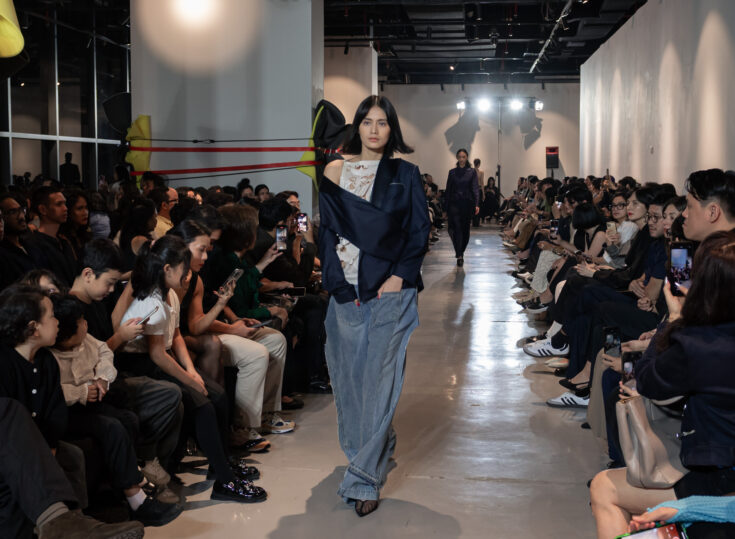In a three part series, ‘Data in Fashion’ with Omnilytics highlights how data analytics support and transform the fashion industry. First up, we look into how data can be used to accommodate the creative process for fashion designers and retailers, along with the possible considerations.
When asked about using data in fashion, Ria Miranda, co-founder and creative director of the eponymous Indonesian modest label, calls herself a late bloomer in that department. For a while, Ria has been relying on what most in the industry probably have when it comes to tracking trends: runway reports on magazines and social media outlets.
But when she came across Omnilytics, a fashion analytics platform from Singapore, the 34-year-old fashion designer learned something rather invaluable: when running a fashion business, relying on instinct alone is simply not enough.
Old way the best way?
Talking about fashion, data analytics doesn’t exactly spring to mind. In an industry where one’s creative vision and artistry are highly regarded, information like statistics can be easily forgotten. But with the advent of social media platforms and e-commerce influencing the way people consume fashion trends, real-time data might just be the industry’s new best friend.
Last year, Indonesia topped the list as the fastest rising e-commerce country with clothing being the dominant sector for spending—a nod to the flourishing homegrown brands that are making waves in the local fashion scene. Yet, in areas where data analysis can help create retail opportunities, some fashion brands still settle for the traditional ways of decision-making, such as looking back at sales history, reflecting on experience and trusting intuition. This begs the question, are they enough?
Data is supporting, not dictating.
Fashion analytics platforms like Omnilytics frames it differently: data exists to support, and not dictate. The company started with the conviction that brands can grow by spotting opportunities and gaps in the market through the use of data and acting on it the right way.
With the platform, information such as price, colour and sizes are collected from websites, which then goes through comprehensive analysing and up-to-date tracking in the global market. By means of data gathering and processing, Omnilytics connects raw data points from across 75,000 brands worldwide and presents them in ways that are visually and easily interpreted for companies to digest.
Ultimately, it’s all about performance data. From identifying trends and colour selections, to setting pricing strategies and knowing which products to stock, Omnilytics helps inform fashion designers and retailers of what to improve in the product development process.
“Potential opportunities are left on the table when you lack visibility into the market and your competitors,” said Sylvia Yin, co-founder and COO of Omnilytics. “Access to data gives brands granular insights into what styles, colours, sizes or even patterns are actually performing, allowing them to make informed decisions to meet market demands.”
This rings true for Ria Miranda, who has been using the platform for over a year. Started in 2009, the eponymous label is one of the most well-known modest fashion brands in the country. With its feminine and modern take on modest apparel, the brand has spread its wings to the international podium through seasonal collections.
While it’s too soon for the label to experience the data impact, it goes without saying that the platform has eased the planning stage. “Using data has helped my team and I to figure out what our market actually needs” said Ria. “It’s a real time and energy saver, especially during the production and designing process.”
Even so, Ria still banks on her creative vision. When creating a new collection, she equates it to “30 percent data, 70 percent the team’s vision”. There’s also the added inspiration and feedback from her customers, which is known as the Ria Miranda Loyal Community (RMLC); the members have reached over 170,000 across the country. “We know our customers even before using [Omnilytics], but the tool strengthens our strategies and sharpens it into detail, especially for pricing points and what trends that are in right now.”
On the running misconception that using data means abandoning one’s creative vision and intuition, Ria stresses the importance of knowing your own brand. “Trends come and go, but our brand’s DNA will be our characteristic– this should be established first. Once you find that, data will ease the process.”
The right tool is data
For Emmelyn Gunawan, the brand figure behind multi brand stores Escalier, Canaan, Unearth and Niniveh Space, the use of data analytics may not be for everybody, yet. Considering the niched nature of her boutiques—think artisanal, high-quality and curated—relying on data to both curate and design may not feel as significant in comparison to other brands who are more catered to the widespread market.
After almost ten years running retail, Emmelyn grows to depend on her own observations, research (mainly from the internet, magazines and social media) and gut-feel to know what makes or breaks the business. Let’s just say, she has found her “formula”, and data analytics is not an integral part of it. From her observations of operating stores in Bali and Jakarta alone, she’s learned that both places have different demands: stores in the capital requires events or workshops for people to gain brand awareness, whereas in Bali, whose customers are 90 percent foreigners, Emmelyn relies on the peak and low season as momentum to launch her products.
“Our stores have their own unique selling point and each caters to a different market climate. It’s hard to compare them side by side, or even with other brands in the local market, because there’s not many stores like us here,” said Emmelyn. “When comparing, we actually look to the market outside instead, and see what can be applied here.”
Still, handling multiple stores back-to-back can’t be easy. In this aspect, Emmelyn agrees that maintaining information such as sales and inventory with data analysis services can be very helpful. “Especially when you want to know which and the number of products to stock.” But here’s where data can be limiting. “When it comes to the creative process [designing and curating], I cannot simply rely on data. You can never be sure when it comes to the market, you still need that human interpretation to do both.”
The same dilemma faces Amanda I. Lestari, founder and creative director of Indonesia’s eco-ethical fashion brand, Lekat. Since the label’s inception in 2013, Lekat—which means “lastingly memorable”—has risen to the local and international stage for its embrace of Baduy hand-woven textile, transforming them into clothes, bags and unique accessories.
For the designer, bringing her vision to life includes balancing her own idealism with where the market is actually going. To put simply, Amanda meshes her creative vision with her own research about what is currently trending right now, what people are wearing or what other brands are doing. This is why every time Amanda designs something new, she always makes sure to create varying looks to appeal to different range of consumers.
But this doesn’t always run smoothly. Case point, Lekat’s Spring/Summer 2020 collection, where Amanda wanted to try new things beyond Baduy textile, such as incorporating tie dye, digital prints as well as upcycling materials from unused patchworks to create casual looks. “Many people said the collection seems different and too simple for their liking,” recounts Amanda. “I took a risk with that, but having seen the response, I learned much about my own brand. I realised that Baduy fabric is not meant for something so simple.”
Could this turn out differently had Amanda relied more on data? That’s arguable. Designing-wise, Amanda still relies on old-school means of researching, paired with her own gut-feel. Historically, it’s something that has always been done. But with the fast-paced trend adoption in the industry, it makes a case for what could be done to improve the creative process.
As such, Amanda believes that a trend-tracking platform that specifically accommodates the Indonesian market would greatly help with the preparation. “Something like WGSN (trend forecasting company),” said Amanda. “Every business always goes through a rut at some point. I think a platform like that would be so helpful if I want to branch out, both physically and online.”
The future of data
So, what does this tell us about the use of data analytics in the fashion business? For some, like Emmelyn and Amanda, it’s situational—maybe it’s not the right time yet, maybe it’s not needed yet. For others like Ria, it proves to be greatly helpful, especially during the planning stages.
While the use of data analytics may still seem foreign here, it’s in fact a tool that is being naturally adopted in the industry outside. No strangers to this are Italian fashion houses Marni and Miu Miu who have been putting data-driven tools to use. As reported by Vogue in the article “Analytics are reshaping fashion’s old school instincts”, Marni was able to build product ranges and set prices for its collection through the use of data. Likewise for Miu Miu, who has used similar software to analyse social media behaviours of their followers. With more and more brands acknowledging its uses, they also steer clear of the bias that data overshadows the creative process.
Ultimately, data is there to help, not deviate. In a competitive and fast-paced industry where consumers are well accessed and informed with the current happenings, data can help brands understand further what people “want, when they want it and at what price point,” said Sylvia of Omnilytics.
“Brands no longer dictate what’s in or out. Consumers are in control now. Lacking accurate market information, retailers make important decisions with guesswork. What brands need to succeed is the ability to detect early trends’ signals, act fast and meet customers’ demands ahead of the competition.”
Visit Omnilytics to know more about the use of data analytics and its services.














